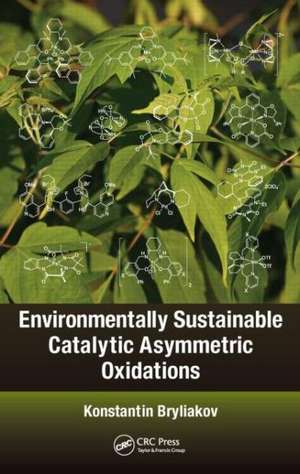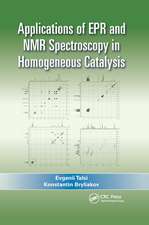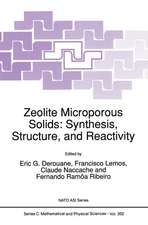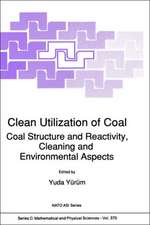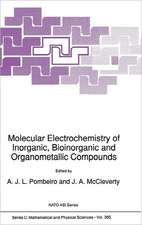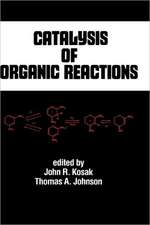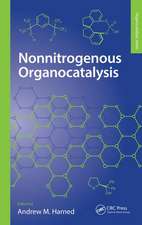Environmentally Sustainable Catalytic Asymmetric Oxidations
Autor Konstantin Bryliakoven Limba Engleză Hardback – 17 sep 2014
Topics include:
- A survey of existing transition metal-based catalyst systems for asymmetric epoxidations (AEs) with O2 and H2O2
- Asymmetric sulfoxidations with H2O2 on chiral metal complexes
- An overview of various transition metal-catalyzed oxidative transformations with H2O2 or O2 used as the terminal oxidant
- Organocatalytic asymmetric oxidations
- Catalytic processes of stereospecific oxidations of C-H functional groups
- The role that oxoiron(V) intermediates play in chemo- and stereoselective oxidations catalyzed by non-heme iron complexes
Some of the catalysts presented in this book may serve as promising alternatives for existing catalysts—progressively replacing them in manufacturing processes and ultimately making the chemical industry greener and cleaner.
| Toate formatele și edițiile | Preț | Express |
|---|---|---|
| Paperback (1) | 309.21 lei 43-57 zile | |
| CRC Press – 14 oct 2024 | 309.21 lei 43-57 zile | |
| Hardback (1) | 1013.11 lei 43-57 zile | |
| CRC Press – 17 sep 2014 | 1013.11 lei 43-57 zile |
Preț: 1013.11 lei
Preț vechi: 1440.95 lei
-30% Nou
Puncte Express: 1520
Preț estimativ în valută:
193.85€ • 202.95$ • 160.40£
193.85€ • 202.95$ • 160.40£
Carte tipărită la comandă
Livrare economică 07-21 aprilie
Preluare comenzi: 021 569.72.76
Specificații
ISBN-13: 9781466588578
ISBN-10: 1466588578
Pagini: 164
Ilustrații: 238 black & white illustrations, 23 black & white tables
Dimensiuni: 156 x 234 x 15 mm
Greutate: 0.36 kg
Ediția:1
Editura: CRC Press
Colecția CRC Press
Locul publicării:Boca Raton, United States
ISBN-10: 1466588578
Pagini: 164
Ilustrații: 238 black & white illustrations, 23 black & white tables
Dimensiuni: 156 x 234 x 15 mm
Greutate: 0.36 kg
Ediția:1
Editura: CRC Press
Colecția CRC Press
Locul publicării:Boca Raton, United States
Public țintă
AcademicCuprins
Introduction. Transition Metal-Catalyzed Asymmetric Epoxidations. Manganese Systems. Iron and Ruthenium Systems. Titanium Systems. Systems Based on Other Metals. Transition Metal-Catalyzed Asymmetric Sulfoxidations. Vanadium Systems. Titanium Systems. Iron Systems. Systems Based on Other Metals. Miscellaneous Transition Metal-Catalyzed Asymmetric Oxidations. Cis-Dihydroxylations of Olefins. Baeyer-Villiger Oxidations. Oxidative Kinetic Resolution of Secondary Alcohols and Desymmetrization of Meso-Diols. Enantioselective Aerobic Oxidative Coupling of 2-Naphthols. Enantioselective C-H Oxidations. Organocatalytic Asymmetric Oxidations. Epoxidations. Miscellaneous Oxidations. Fe- and Mn-Based Synthetic Models of Non-Heme Oygenases: Stereospecific C-H Oxidations. Iron Systems. Manganese Systems. Active Species and Mechanisms of Non-Heme Fe- and Mn-Catalyzed Oxidations. Iron Systems. Manganese Systems. Industrial Perspective. General Remarks. Some Examples. Outlook.
Notă biografică
Konstantin P. Bryliakov was born in Yoshkar-Ola (USSR) in 1977 and graduated from Novosibirsk State University in 1999. He earned a Cand. Chem. Sci. (PhD) in chemical physics from the Institute of Chemical Kinetics and Combustion (Novosibirsk) in 2001 under the direction of Professor E. P. Talsi. In 2008, Dr. Bryliakov was awarded a Dr. Chem. Sci. in catalysis from the Boreskov Institute of Catalysis (Novosibirsk). Dr. Bryliakov is a leading research scientist at the Boreskov Institute. He has co-authored more than 90 papers, book chapters, and patents. His research interests include transition metal-catalyzed asymmetric oxidations, single-site olefin polymerizations, and mechanistic aspects of those transformations.
Descriere
Catalysis plays a vital role in the chemical, petroleum, agriculture, polymer, electronics, pharmaceutical, and other industries. This book provides a comprehensive overview of existing catalyst systems for various types of catalyzed asymmetric oxidation processes exploiting "green" oxidants H2O2 and O2. In addition to traditional transition metal catalyzed oxidations, it also considers organocatalytic processes. The book discusses catalytically active sites and reaction mechanisms. It also considers the viability of some catalyst systems from industrial and green chemistry perspectives.
